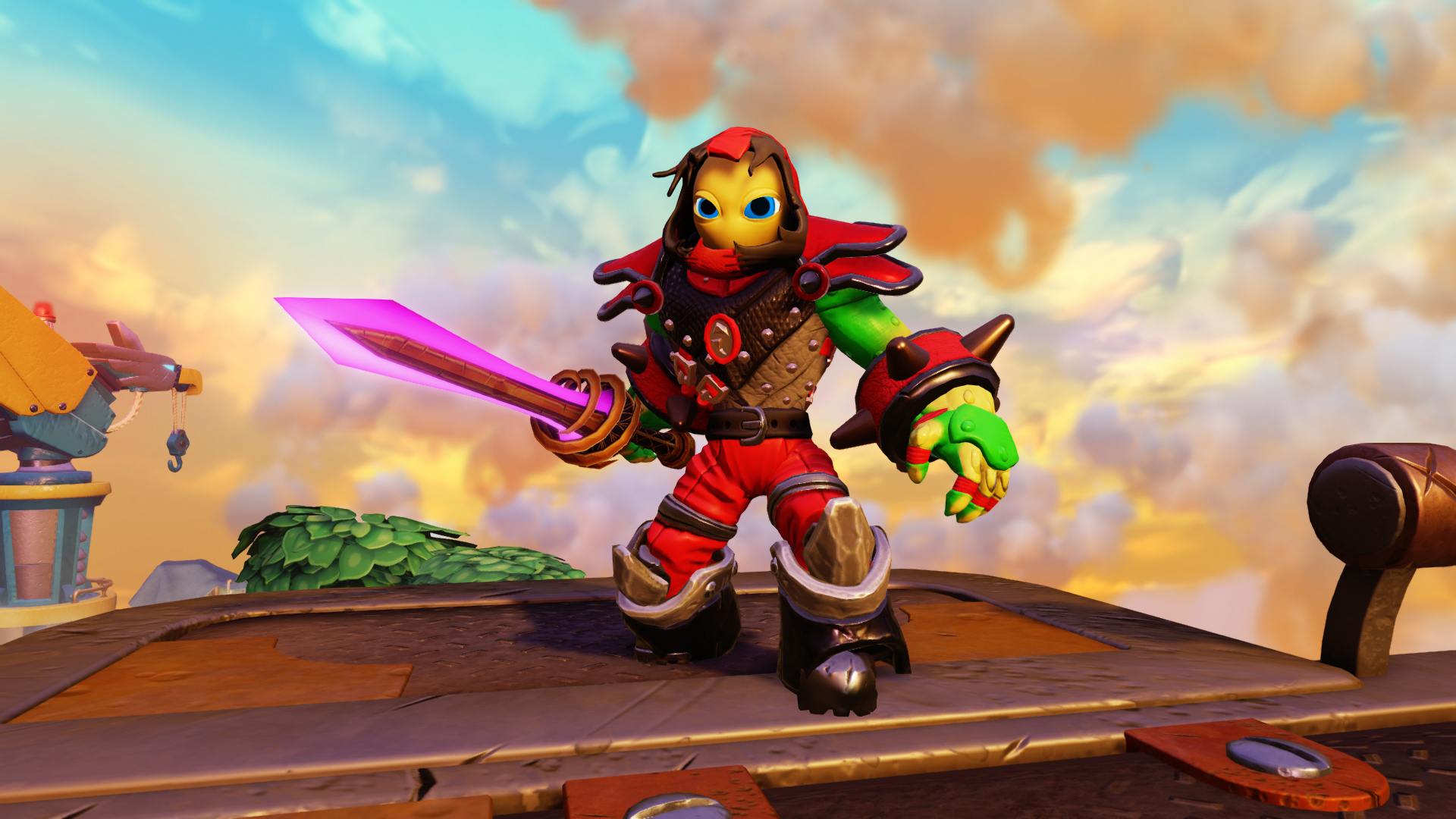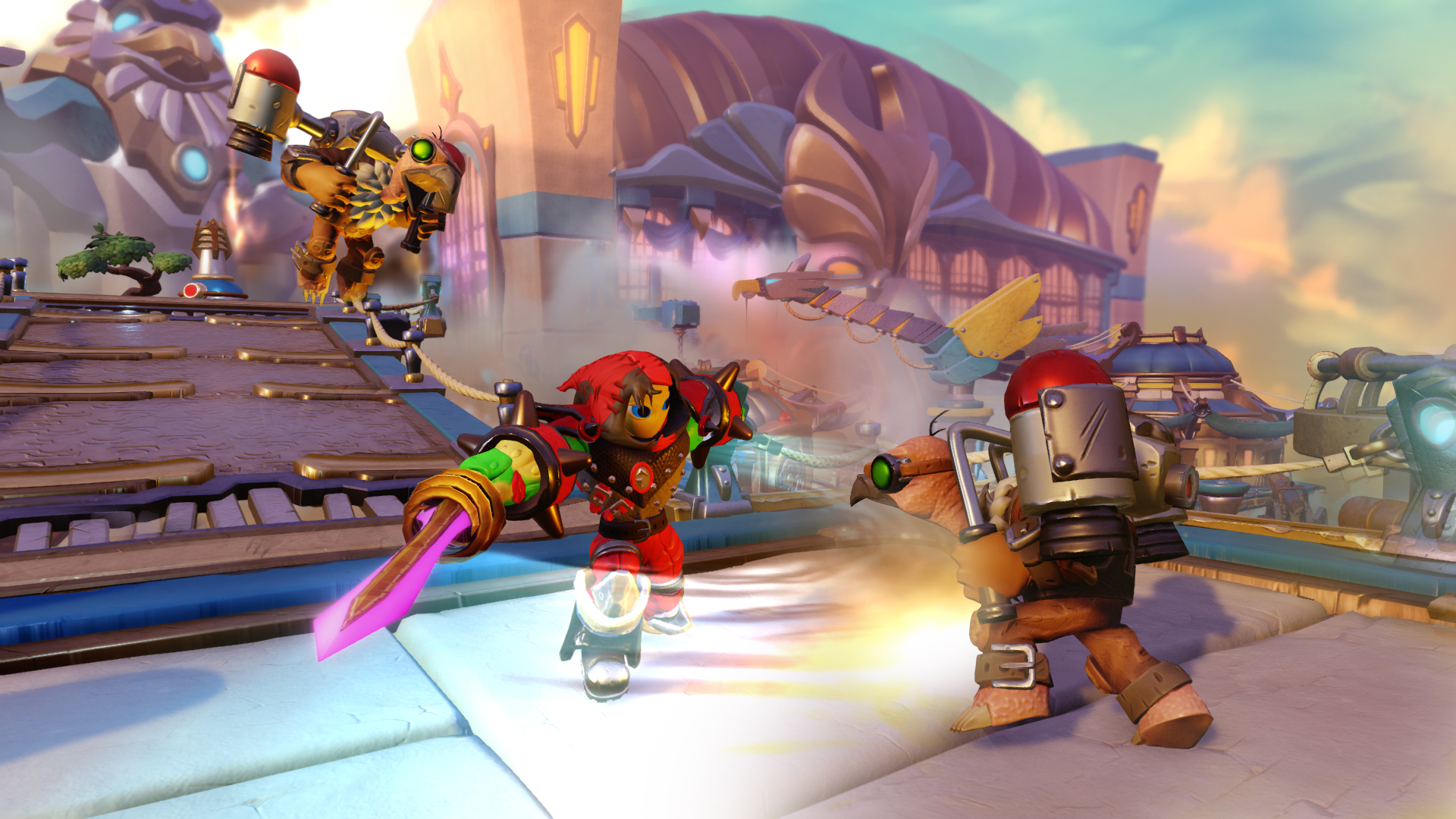
I’m staring at a creature that shouldn’t exist, a zoomorphic mashup of anatomical incongruities. It has the head of a squid and the frame of Hulk Hogan, like a cartoonish Atlantean bodybuilder out of a Lovecraftian kid’s book. Crimson corncobs protrude from its temples. Its tail is a rainbow plume. At the press of a button it bellows “I will avenge rock and roll!” in perfect metal falsetto.
I’ve just built the world’s weirdest toy-hero in an early version of Skylanders: Imaginators, a radical rethink of studio Toys for Bob and publisher Activision’s multibillion-dollar toys-to-life franchise. Skylanders: Imaginators is set to arrive on current and last-gen consoles October 16.
Activision launched the so-called toys-to-life category five years ago when it introduced the Skylanders franchise as a hybrid genre that encouraged players to collect figurines that interact with console games. The higher prices—sets can costs $100—led to competition from Nintendo, Disney, and Lego among others. But since Disney’s announcement earlier this year that it was shuttering its the toys-to-life Infinity line and taking a $147 million write-down on its games business, questions have swirled about the genre’s future. Sales in the category were flat in 2015 at about $1.25 billion worldwide.
Pull back to a conference table spilling over with sheets of multicolor paper and kaleidoscopic artwork, and it becomes clear Activision believes there’s a lot of life left in the category. Each page sports a unique drawing of an imaginary being by a child. The pages are flush with strange math and words to describe every anomalous appendage. Some are humanoid, others not, but all are detailed, beguiling and clearly loved.

“We get thousands and thousands of these letters from kids all around the world,” Activision senior producer Chris Wilson tells me, drawing my attention to one in particular—a formidable-looking critter with the words “Fire Turtle” scrawled at the top of the page. “They’ve been coming in since Spyro’s Adventure [the first Skylanders game, released in October 2011],” he says, adding that the pictures culminated in a light bulb moment for the team. “It was like ‘Hey, this is what kids want to do, because this is what they’re already doing,'” he says.
That led the studio to begin working shortly after 2014’s Skylanders: Trap Team toward what I’m now watching Wilson play: A version of Skylanders that when it arrives this fall will let players finally roll their own heroes—a first for the toys-to-life category.
Wilson hefts a small plastic pillar with a translucent object lodged in its midsection. “This is the new toy type we’re calling the creation crystal,” he says, describing it as a piece of “pure, unrefined imaginite.” That’s what the studio’s dubbed the elemental material into which players will pour their fantastical Franken-beings, transacted by dint of something the story refers to as “mind magic.” Series big-bad Kaos is doing the same, of course, using “mind magic” to rustle up an army of Doomlanders (another category newcomer) players are on the hook this time to defeat.
Here’s how it works: Wilson places the creation crystal on a small toy platform that’s known in series parlance as a “portal of power.” Wireless voodoo happens, the imaginite illuminates, then begins to pulse rhythmically. “It’s their heartbeat,” says Wilson as the game launches a cosmic creation routine that visualizes each formless pre-being as a mass of stars.

From here, players can select any of 10 archetypal battle classes with names like “ninja” or “brawler” or “bazooker” before turning to menus that’ll let them add unique abilities and special moves, as well as items and weapons that yield combat bonuses. At no point does any of it feel convoluted, and friendly tropes abound. Thus as you’d expect, archers brandish bows and arrows, while smashers draw from a blunt-force arsenal that includes stuff like clubs or maces.
But the Imaginators feature kids are probably going to dig most is the creation tool’s half-serious, half-goofball personality tweaker. Here players can modify anything from physical girth to appendage type to the signature catchphrase a Skylander shouts when it’s summoned. Add the “underwater” effect to make a Skylander sound like it’s chortling, for instance, or the “radio” one to give it a hammy, disc-jockey vibe. Pick a funk or country motif and it’ll play during battles, then fold in sound effects like “cartoon” or “gassy” to give combat moves jokey pizzazz. Mix a sentence fragment such as “I like” with follow-ons like “fire” or “flower power” or “rock and roll” and your Skylander will vocalize accordingly. All of which explains how I wound up creating a flatulent bodybuilder squid that funks out when it fights and hurrahs with the vocal brio of Meat Loaf.
There are limits, of course. “We wanted it to be a somewhat curated experience, just so it’s safe for kids,” says Wilson when I ask if they considered folding in a 3D modeling tool. You’re selecting from a prebuilt library of forms and functions, in other words. “But we have a lot of parts,” he adds. “We did the math, and if you add up all the possible permutations, the number’s so high that it’s effectively unlimited.” If you’re intimidated by all that “unlimitedness,” there’s a randomization option that’ll roll the dice on everything at the tap of a button.
What does Imaginators play like? The level I watched Wilson bash his way through was familiar enough: A vibrantly colored, action-adventure-platforming mashup, with scads of breakable objects and squadrons of enemy assailants. “As in prior years, we have a mix of combat, puzzle-solving, mini-games and platforming,” says Wilson as he’s walloping foes. “So as you go through each of the levels, we’ve paced it to keep you on the edge of your seat, whether you’re rail-grinding, or doing a lock pick puzzles, or using skystones [a mini-game introduced in Skylanders: Giants].” That’s right, they’re bringing skystones back this year.

Players can also unearth “imaginite chests” that spawn after certain battles or lurk in hidden areas. These spill random loot you can then use to reconfigure your Skylander, say equipping rolling pins, or battle skillets, or the acoustic guitar we found during my demo. (I’ll leave to the imagination what a smasher-class Skylander’s going to do with any of those.)
So where are the actual toys-to-life? The answer involves 31 real-world Skylanders the studio’s calling Sensei. (Like the lowercase ‘s’ word signifying a martial arts guru.) “These are characters that represent the epitome of the different battle classes, that really showcase mastery over those classes,” explains Wilson, handing me one named Tri-tip, a triceratops-inspired smasher with a devastating special move, but who in quieter moment likes to twist a pool chalk on his horns.
Each Sensei has a special meter that builds over time and lets them execute a unique “sky-chi” maneuver. “It’s the most powerful attack we’ve given to any of our Skylanders to date,” says Wilson. “It’s meant to showcase the ultimate power of that fighting style.” He taps a button and Tri-tip rotates in place like mace-swinging tornado, pinballing around the battlefield and toppling Doomlanders like tenpins. What’s more, Sensei can unlock special shrines scattered throughout levels aligned with the 10 battles classes (a move clearly designed to encourage purchase of multiple Sensei). The shrines are a big deal, because they not only unlock class-based creation items, they’ll let you upgrade a Sensei’s sky-chi power.
In another series first, Toys for Bob’s going to let us play as the bad guys—sort of. Eleven of the Sensei are reformed villains from prior games. “It’s something fans have been asking for for awhile now,” says Wilson, explaining that most are from Trap Team, where you could snare them in crystals but only use them for short bursts. Here they have fleshed-out movement sets worthy of the Skylander name.

Wilson drops The Golden Queen on the portal to demonstrate. She’s the avaricious former leader of the Doom Raiders. In Imaginators, she can summon golden scarabs, an A.I. buddy that shoots golden blades or pull off a sky-chi move that unleashes an epic storm of beetles. Though she’ll still say stuff like “I reign supreme!” So reformed, yes, but edgy.
What’s more, dropping Senseis on the portal unlocks creation tool options, including gear, weapons and special techniques for characters in the same class as a given Sensei. And while Wilson tells me the Skylander level cap is still in flux, Sensei raise the max imaginator level. During my demo, it bumped up to 21 when we pulled in Tri-tip, and then to 22 when we summoned The Golden Queen.
Pricing seems in line with past years, meaning slightly north of the $59.99 asking price most triple-A games go for by themselves. This year’s starter pack includes the game, the new portal, two Sensei Skylanders (King Pen and The Golden Queen), and one creation crystal for $74.99. The 20 Sensei plus the 10 reformed villains will cost $14.99 each, and the creation crystals (they can hold one creation at a time) will run $9.99 each. There’s no digital owner’s pack this year, so the only way into the game is through the starter pack.
It’s a lot to think about, but the question I kept circling back to—that begs to be answered in a category so invested in the physical toy-ness of the experience—is this: Will players be able to turn their Imaginators into real-world artifacts?
Wilson smiles as I ask, the smile alone a half-given answer. He can’t say, but I was able to put the question to Toys for Bob founder Paul Reiche (and you can read his response here). Suffice to say, Skylanders: Imaginators may soon have an answer to that seeming conundrum, too.
More Must-Reads from TIME
- Donald Trump Is TIME's 2024 Person of the Year
- Why We Chose Trump as Person of the Year
- Is Intermittent Fasting Good or Bad for You?
- The 100 Must-Read Books of 2024
- The 20 Best Christmas TV Episodes
- Column: If Optimism Feels Ridiculous Now, Try Hope
- The Future of Climate Action Is Trade Policy
- Merle Bombardieri Is Helping People Make the Baby Decision
Write to Matt Peckham at matt.peckham@time.com